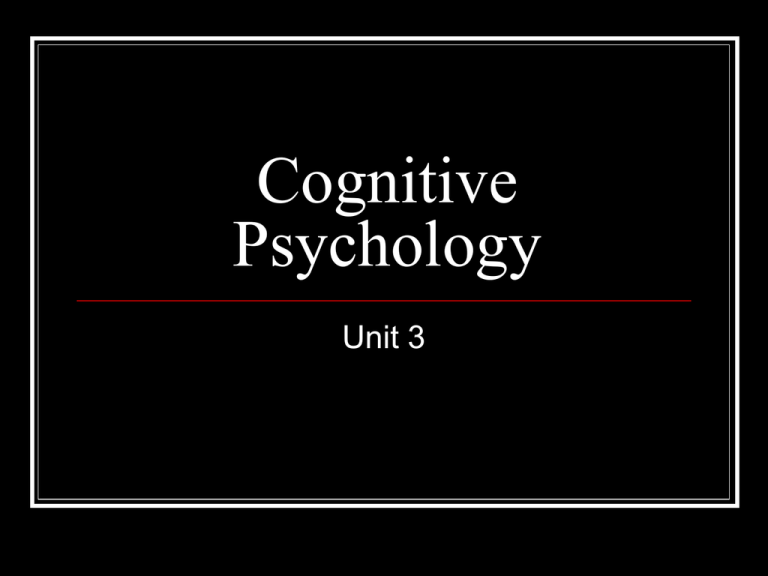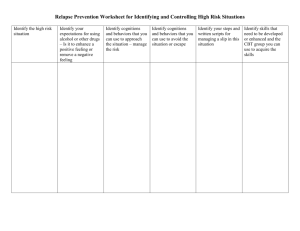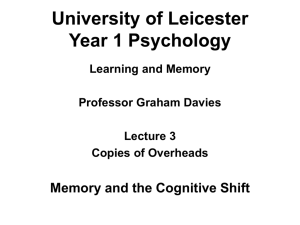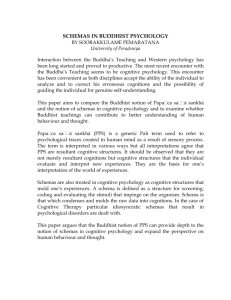Cognitive Psychology
advertisement

Cognitive Psychology Unit 3 Comparing Perspectives Behavioral Psych Cognitive Psych Behaviors Knowledge Reinforcement strengthens Reinforcement is a source behavior of feedback Learners respond to environmental stimuli Learners are active Study done on animals Study done on animals and people What is Cognitive Psychology Definition Key Figures Basic Assumptions Definition Cognitive Approach Approach that attempts to understand us from the point of view of our information processes (cognitions) and how they influence our thoughts, feelings, and behaviors Key Figures and Contributions Wilhelm Wundt Founded Structuralism and Introspection Jean Piaget Introduced Theory of Cognitive Development Albert Bandura Structuralism was the root of modern cognitive psychology Introspection-process of observing one’s own mental processes Theories of observational learning and Social Learning theory Julian Rotter Theories of Social Learning theory and Locus of Control Lesson Closing Get Sheet of paper on Cognitive Psychology from back of room Task #1: Write 3 Things that are important to know about Cognitive Psychology: Write one way in which cognitive psychology is different from either behavioral or psychodynamic perspective Bell Work Come in and get reading right away After 15 Minutes; Get notes outline ready for notes! Basic Assumptions Cognitive psychology is a pure science, based mainly on laboratory experiments. Behavior can be largely explained in terms of how the mind operates (Information Processing) The mind works in a way similar to a computer: inputting, storing and retrieving data. Mediational processes occur between stimulus and response. Also called cognitions and Information Processing Key Concepts Cognitive Development Observational/Social Learning Locus of Control Reciprocal Determinism Multiple Intelligences http://psych.hanover.edu/JavaTest/CLE/Cognition/Cognition/shapeResp_in structions.html Locus of Control Internal Control over future events/outcomes relies primarily on self Believes success/failures in one’s own hands External Control over future events/outcomes is outside of self. Either in hands of powerful people, or in fate/chance Believes success/failures in other’s hands Examples: Grades in School It doesn’t matter how hard I study; the teacher doesn’t like me. External The harder I study the better grades I will get. That play didn’t work because I missed my assignment Internal That play didn’t work b/c our coach called a dumb call Internal External http://www.youtube.com/watch?v=wTNQiYJxrWg Concepts Reciprocal Determinism Theory that a person's behavior both influences and is influenced by personal factors and the social environment. Behavior is controlled by person through thinking and by the environment through external social stimulus events. Child-Acting Out in School Example Reciprocal Determinism Example School / teacher dislikes child Methods used to stop misbehavior Constant Battle Poor environment for teachers / other students Child Hates School Misbehavior Doesn’t Want to be there Concepts Multiple Intelligences Developed by Howard Gardner in 1983. Suggests that intelligence cannot be defined by a simple number (31 on ACT) People have capacity to solve problems and demonstrate intelligence in many ways, not just with numbers/words 8 Multiple intelligences 1. Verbal-Linguistic: abilities to use vocabulary, do verbal analysis, understand metaphors, and comprehend and produce complex verbal material 2. Logical-Mathematical: involves numbers and computing skills, recognizing patterns and relationships, timelines, ability to solve different kinds of problems through logic 3. Visual-Spatial: involves visual perception of the environment, ability to create and manipulate mental images, and the orientation of the body in space 4. Bodily-Kinesthetic: physical coordination and dexterity, using fine and gross motor skills, and expressing oneself or learning through physical activities 5. Musical-Rhythmic: understanding and expressing onself through music and rhythmic movements or dance, or composing, playing, or conducting music 6. Naturalistic: understanding the natural world of plants and animals 7. Interpersonal: understanding how to communicate with and understand other people and how to work collaboratively 8. Intrapersonal: understanding one's inner world of emotions and thoughts, and growing in the ability to control them and work them consciously Concepts Cognitive Development Theory of construction of thought processes, (remembering, problem solving, and decisionmaking) forming from childhood through adolescence to adulthood. 4 Stages Sensorimotor- motor skills Pre-Operational- symbols Concrete Operational- Logical and systematic observation Formal Operational- symbols and relation to abstract concepts Key Concepts Albert Bandura Observational Learning Social Learning Theory Same thing occurs when an observer's behavior changes after viewing the behavior of a model. An observer's behavior can be affected by the positive or negative consequences they observe Key Concepts Lesson Closing Task #2 Read Article on Cognitive Psychology http://psychology.about.com/od/developmentalps ychology/a/sociallearning.htm?p=1 Give me 3 Important things about Social Learning Theory What are the 3 main points of the article? They will be listed Bell Work Concepts Mediational Processes Information Processes (Cognitions) Computer Analogy Introspection Schema Machine Reductionism Cognitions Memory Perception Attention Language Thinking Mediational Processes Big 5 Cognitions Another name for information processes or cognitions Called mediational because they come between the stimulus and the response Information Processes Name used to describe our cognitions These cognitions help people make appropriate behavior responses to their world Perception Attention Language Memory Thinking Computer Analogy Shows from cognitive theory why we think, feel, and behave as we do. Input is what our senses pick up about stimuli in the world. It is then processed using the 5 cognitions into a response Output is that response that comes after the input and processing of the stimuli by the 5 cognitions Input to Processor to Output Stimulus to Mediational Process to Response Thinking Ability to problem solve and use “wholebrain process.” Information Processes Perception Active Information process. Allows us to organize, interpret, and act on outside stimuli People may sense the same stimulus but their past experiences (perceptions) will often result in a different behavior Example? Seeing a young gentleman walk by 1 girl likes him Another disagrees; recently part of domestic violence so her experiences have changed her outlook towards men Information Processes Attention Cognitive ability to attend to one thing at one time (focused) or all things at all times (divided) Information Processes Language Our ability to communicate Verbal language, retention, and comprehension Poor Readers Example? Information Processes Memory Helps us to organize, store, retrieve, and recognize information from the world Input to memory is called encoding Output of memory (usage) called decoding Information Processes Introspection Self-observation and reporting of conscious inner thoughts, desires and sensations. Important to Cognitive Therapies because it helps the person look into their own behaviors and see their true causes/outcomes Concepts Schema Mental structure that represents some aspect of the world used to organize current knowledge and provide a framework for future understanding Important in Big 5 Cognitions and to how we respond to certain stimulus in the environment. This is what helps you develop stereo-types, social roles, and world-views Concepts Machine Reductionism Breaking down of a complex concept/idea into smaller components to help understanding Important to Cognitive Psychology b/c they break down Cognitions into 5 main themes to help understand…. Then they also break down those five cognitions http://psych.hanover.edu/JavaTest/CLE/Cognition/Cogni tion/shapeResp_instructions.html Concepts






